Motorcycle Investor mag
Subscribe to our free email news

Generation R
(September 2020)
by Guy 'Guido' Allen
Suzuki’s GSX-R750 spawned a whole new generation of
sports tackle 35 years ago. Let's go for a fang down
memory lane…
See our GSX-R1100 feature here
Just imagine that someone walks up to you this afternoon and says you can have a fair dinkum replica of a Suzuki MotoGP monster, with lights and number plate, new, for let’s say about $18,000. Would you buy it? Hell yes. Would it turn the sports bike market on its head? Probably, but maybe not as much as the first GSX-R did in its day.
It is difficult to overstate the impact the GSX-R750 had
on the local, and world, market. And to get across just
what a revelation the first version really was. While we
hear plenty of hype about how a new design revolutionises
a class, blah blah, the Gixxer really did, and it was
years before the other Japanese makers stuck their necks
out quite so far when it came to producing an affordable,
ultra-light and serious racer rep for the road. In many
ways, it defined what we now accept as super-sports
motorcycles from Japan.

CLASSIC STATUS
Hard as it is for some of us to believe, the first model
GSX-R750 is now 35 years old. Where in hell did the time
go?
Okay, so let’s think back to late 1984, when the bike was
announced (for the 1985 model year) and Australian dealers
began decorating their shops with the very first GSX-R750
posters. While not exactly a new idea, the prospect of
being able to buy a real racer with lights from one of the
big four makers was, at the time, absolutely mouth
watering. And here it was. An honest-to-god race-bike that
looked damn-near identical to the GS1000R that nailed the
1983 Suzuka Eight-Hour.
The posters (how I wish I’d grabbed some copies at the
time) proudly screamed two all-important numbers: 100
horsepower and 176 kilos. So what? In those days, you
might as well have claimed to have fitted a rocket engine.
A century of neddies was well into litre road bike
territory, while the claimed dry weight was, frankly,
incomprehensible. We’re talking 40-50 kilos less than the
accepted four-cylinder contemporaries of the day. The
numbers alone made it abundantly clear that it would,
regardless of engine capacity, eat alive anything else in
the Suzuki armory and, by implication, pretty much anyone
else’s.
As it turned out, the model did not quite succeed in
wiping the floor with everything else on the racetrack,
though it met with a lot early success in production
racing here and superbike plus endurance events across the
globe. Yamaha’s marginally later FZ750, for example, was a
more road-oriented machine which was forever giving the
Gixxer a hurry-up.
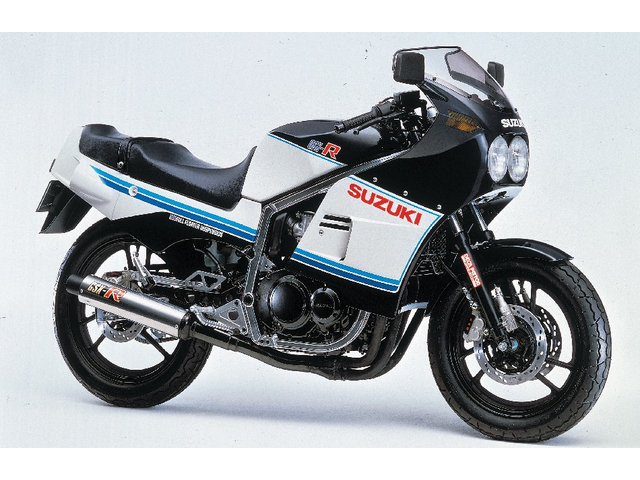
ONE-BIKE BRAND
While we may not have understood it at the time, the
GSX-R750 effectively established what was to become a
narrow brand in its own right. Though the world saw the
750 as the parent of the GSX-R phenomenon, there was in
fact a quiet predecessor in the shape of the GSX-R400 of
1984 (above).
Pitched primarily at the domestic market (hence the engine
capacity) the 400 ran a liquid-cooled heart in an alloy
frame, wrapped in an endurance-style styling package. It
claimed to be a hefty 18 per cent lighter than its
competition and won huge praise for its sporting ability.
While the 400 was the stalking horse, it was the 750 which
was the main game.
If the raw power and weight numbers got your pulse going,
a harder look at the 750 spec sheet was a performance
hound’s dream. For a start, there were flat-slide carbs as
standard – everyone knew these were the choice of race
teams. Then there was the beefy (for the time) 41mm front
fork, an alloy frame for all to see and, strangely enough,
an oil rather than water-cooled engine design.
The justification for that little item ran along the lines
that it could do pretty much everything a ‘normal’
liquid-cooling system could achieve, but with less weight.
Work on this idea had been underway for some time. The
air-cooled GS1000R world endurance race engine employed
oil-cooling jets on the underside of its pistons, which in
turn had been developed to control the heat range of the
far less successful XN85 turbo street bike.
All this added hugely to the bike’s street cred, as did
the fact that it really did mirror much of the development
done to make the GS1000R so successful. The chassis,
according to design team member Akimasa Hatanaka, was the
subject of “a lot of heated discussions. How should we
weld the frame? What materials are best? In a lot of ways,
we were groping in the dark. But we had the race
experience to lead us. We knew that following what worked
in racing would help.”
Colleague and team leader Etsuo Yokouchi, convinced there
was a need to move away from what he saw as hitherto
overly conservative design, felt racing experience could
and should be more closely translated to the street. “The
motorcycle doesn’t know where it is being ridden,” he once
said.
There is of course an argument that the team may have
overshot the mark, as the first model GSX-R750 – the F –
was notoriously nervous at high speed, something addressed
by a 25mm longer swingarm in the 1986 G model (below).
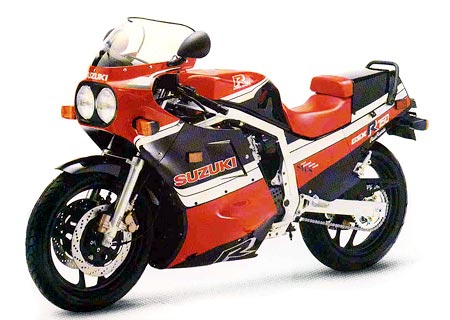
IN THE SADDLE
So what was the first Gixxer really like? My memory of
hopping aboard a test bike in early to mid 1985 is an
overwhelming sense of “what the devil have we got here?”
The machine had already begun racing locally with some
success, and the raw stats were on a different planet to
those for the Suzuki GS1100G I owned at the time. Like
nearly 70 kilos lighter, with more horsepower, and what
seemed like half the physical size, plus a steering
geometry that wasn’t recognisable as the same vehicle.

Ignoring the spec sheet, you were immediately confronted
with two bleeding obvious novelties: a race-style seating
position, and a tacho that started at 3000rpm on the first
version. That was quickly updated to dial set you see
here.
A quick note for collectors: if you see three large dials
(below) instead of the two above, it's a Japan-market
bike. Check the numbers on the speedo, as they're normally
marked to 180km/h. This example has been retrofitted with
a UK market gauge.
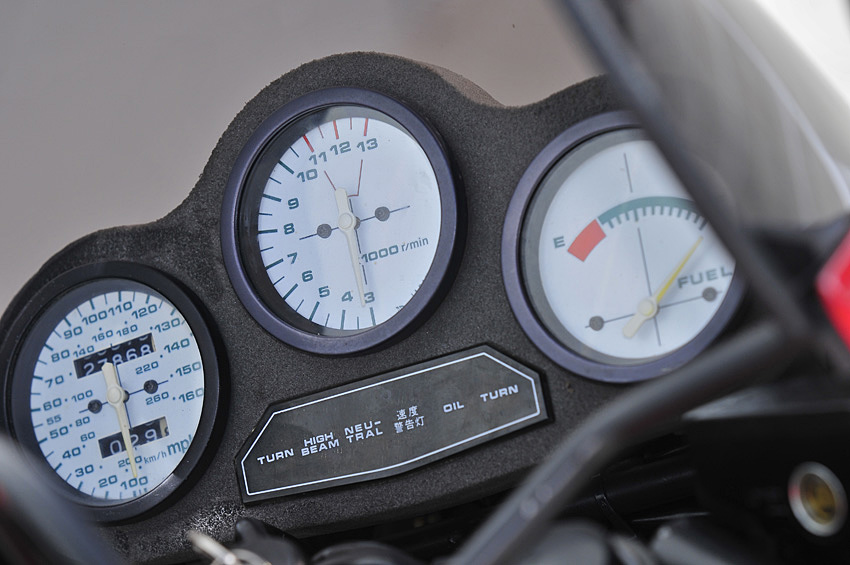
Hit the starter and there was immediately an aggressive
growl – something which Suzuki has tried very hard to
retain over the series – that had the timid corner of the
brain questioning whether what you were about to do was
either necessary or even a good idea. Clearly it wasn’t
and therefore it was.
Damn it was fast and, on the rare occasions you actually
got time to think about it, hellishly uncomfortable.
Frankly I didn’t get to ride it in circumstances where
stability became a life-threatening issue, but there was
no question it was a lightning-fast steerer for the day
that demanded your full attention if you were going to get
within cooee of exploring its considerable abilities.
Responsive, fast, and much better than a mere mortal like
me. That about summed up an afternoon’s play with the toy.
Oh, and surprisingly, it was accessible. It started
easily, idled, could be ridden at normal speeds by any
dill, and gave every indication of being a solid, reliable
mount at a halfway reasonable price. That last factor was
the real kicker for a whole generation of riders – here
was a very serious sports machine at sensible dollars. If
you had a job, you could probably find a way to finance
it.
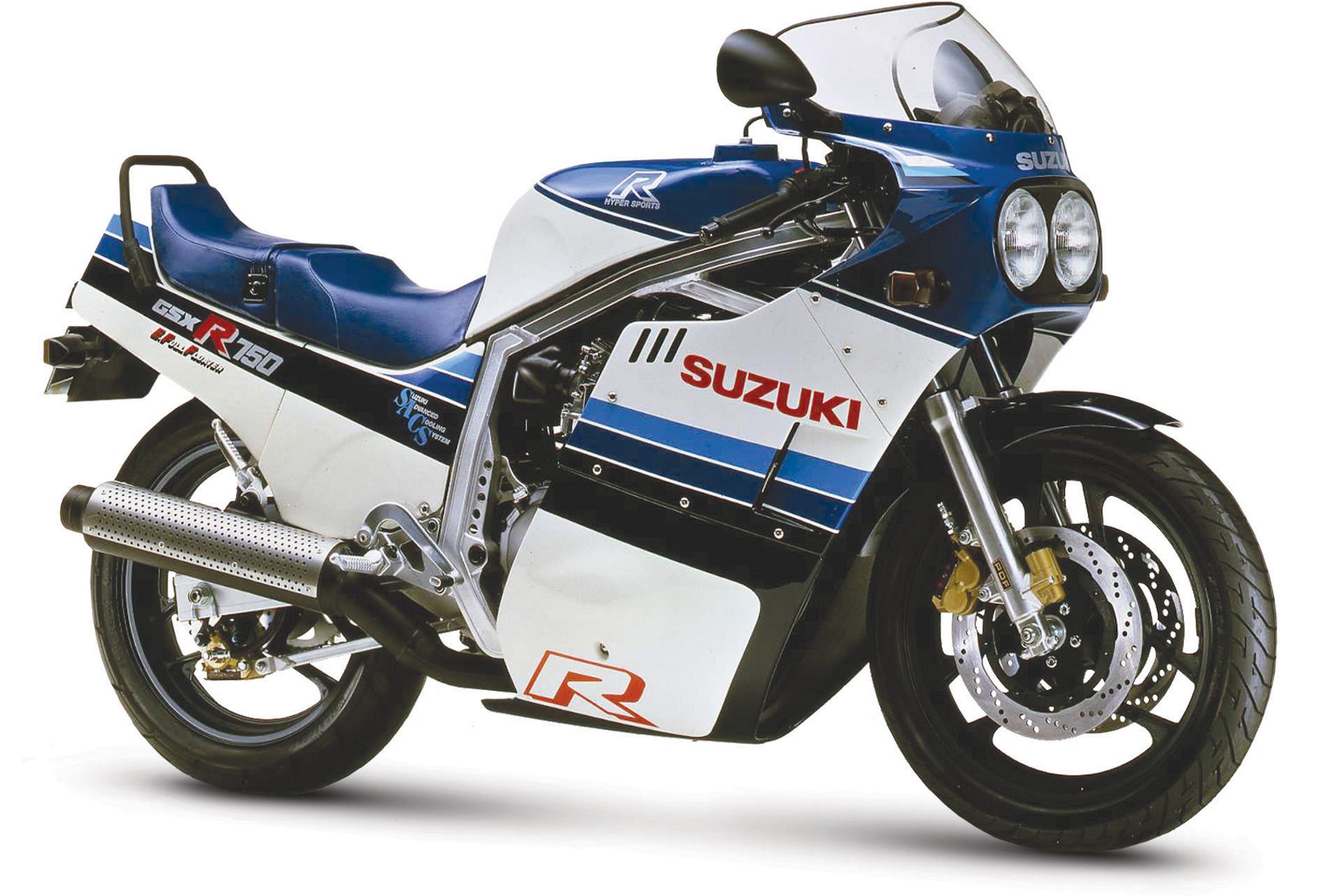
20-20 HINDSIGHT
And now? There are plenty of motorcycles out there that
had us in a lather of excitement at launch, but ended up
being treated rather unkindly by history – and Suzuki has
made its share. However the first GSX-R750 stands up well
to the less than sympathetic glare of someone wearing the
hindsight goggles.
A well-maintained one would still be an exciting ride
today, as the power to weight figures still stack up as
something with plenty on tap to make life interesting. Its
handling will feel a little archaic, but still familiar to
anyone who rides current sports tackle – though the
18-inch wheels will look way too tall and skinny to modern
eyes.
You need a little patience to wake it up properly - it’s
cold-blooded by modern standards. Even then, the
carburetion is not slick, and performance can depend on
your ability to show a little sympathy for matching your
throttle hand to speed and gearing.
Get it right and this is a lively motorcycle. A hundred
horses for around 180 kilos still works. It’s also low,
narrow, and surprisingly responsive.
It tips in happily and responds to correction. With its
narrow tyres, it feels like you’re tap-dancing on
stilettos – fine if you’re used to it, but confronting if
not.
This model saw the introduction of four-piston front
brakes for Suzuki and, while they were the hot thing in
their day, they’re just acceptable now.
Suspension had moved on from some of the anti-dive
weirdness of the early eighties and made real attempts to
offer useful adjustability. It works, up to a point, and
now looks as spindly as the frame.
A big issue is finding a decent one. The first F model is
distinguished by a shorter swingarm than the G, plus a
muffler that has round colander-style holes in the alloy
muffler cover, rather than the G’s slots. Both versions
are thin on the ground in anything resembling reasonable
and original condition.
At risk of sending values through the roof, this is a
no-brainer when it comes to collectible status, in F, G of
H form. The F is the first, but the later two are the
sorted versions and will be easier to find.
While the GSX-R1100 became the marque’s standard-bearer in
the performance stakes, from its launch in for the 1986
model year, in its day the 750 was nevertheless one very
formidable bit of kit, along with being a trend-setter
that we may not have fully appreciated at the time. If you
have one of the first generation machines, my advice is to
hang on to it…
*****
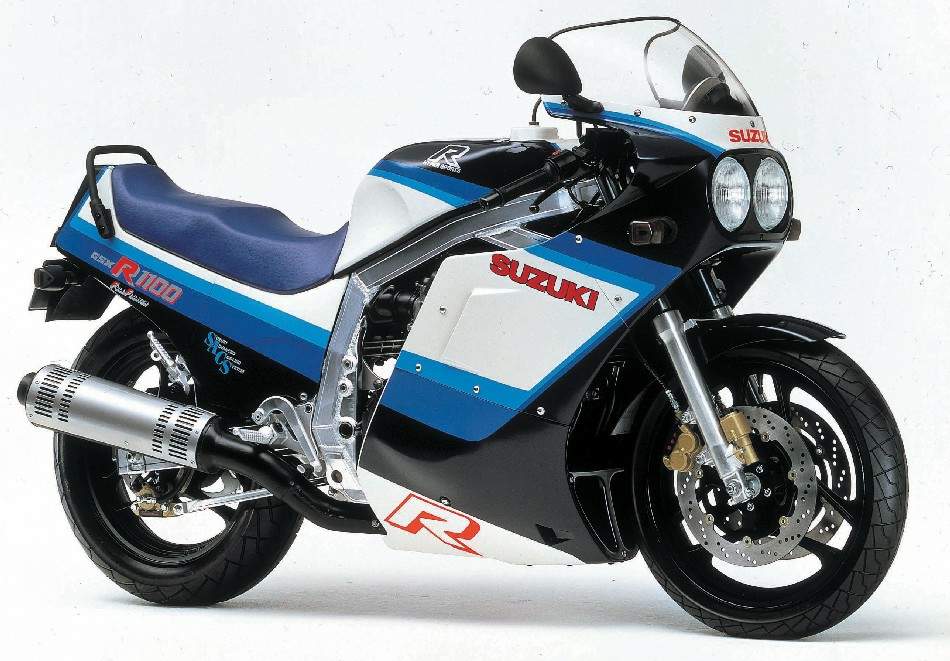
BIG BROTHER
The monster GSX-R1100G (above) was a truly awesome ride
when launched in 1986. Blessed with an entirely believable
130 horses, it was heavier than the 750 at 197 kilos.
However it was a much better ride on the road, feeling
more stable and a little more comfy – though the ride
position was still a wrist-crusher.
It doesn’t have the 750’s race pedigree. However it and
the slightly tweaked 1987 model (H designation) have a
huge amount of performance to offer.
If you’re feeling an unreasonable urge to start collecting
1980s performance bikes, the 1100s arguably offer more
value than their smaller cousins.
See our GSX-R1100 buyer guide.
GSX-R750 RESOURCES
Web: suzukicycles.org
– really good reference material, mostly derived from
contemporary brochures.
Suzuki has a great little archive of pics and stats up to the 2011 model, which you can find here.
Book: Suzuki GSX-R – a legacy of performance, by Marc Cook. Published by David Bull. An excellent reference done for the model’s 20th anniversary, it’s readily available via the web.
SPEX
Suzuki GSX-R750F
ENGINE
Type: Oil-cooled in-line four with four valves per
cylinder
Bore and Stroke: 70 x 48.7mm
Displacement: 749cc
Compression ratio: 9.8:1
Fuel system: VM29SS flat-slide carbs
TRANSMISSION
Type: 6-speed constant mesh
Final drive: chain
CHASSIS & RUNNING GEAR
Frame type: Twin-loop alloy
Front suspension: Conventional 41mm fork, spring and
damping adjustment
Rear suspension: Monoshock, spring and damping adjustment
Front brakes: Twin 310mm floating discs
Rear brake: Single disc
DIMENSIONS & CAPACITIES
Dry/wet weight: 176/185kg
Seat height: 755mm
Fuel capacity: 18.5lt
PERFORMANCE
Max power: 100hp (75kW) @ 10,500
Max torque: 6.4kg-m (63Nm) @ 8000rpm
Price when new: Au$5700 + ORC

-------------------------------------------------
Produced by AllMoto abn 61 400 694 722
Privacy: we do not collect cookies or any other data.

Archives
Contact



